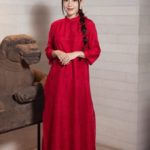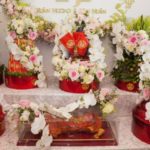A wedding is one of the most significant events in a person’s life, so it’s important to understand the customs and cultural traditions of both families to ensure the event is respectful, joyful, and warm. In this article, we’ll explore the unique wedding customs of central Vietnam.
1 Understanding Wedding Ceremonies
The distinctive feature of central Vietnamese wedding customs is their simplicity, with less focus on material possessions and complex rituals compared to northern Vietnam, and a more conservative approach than the south.
Traditionally, wedding ceremonies in central Vietnam involved six steps, known as the “Lục Lễ,” and took place over three years. However, nowadays, the process has been significantly simplified.
Many complex and intricate rituals have been reduced to three basic steps: the engagement ceremony, the wedding proposal, and the wedding ceremony. Additionally, the wedding proposal and wedding ceremony can be combined if the distance between the two families is not too great.
Engagement Ceremony
Considered the simplest yet most important step in central Vietnamese wedding procedures, the engagement ceremony marks the first official meeting between the groom’s and bride’s families to discuss the wedding.
 The engagement ceremony is the first official meeting between the families to discuss the wedding.
The engagement ceremony is the first official meeting between the families to discuss the wedding.
The engagement ceremony takes place when the couple feels their love is mature enough to take the next step, with the consent of both sets of parents. At this ceremony, the groom’s family, along with their son, chooses an auspicious date for the wedding and discusses it with the bride’s family. Once the bride’s parents agree, the groom’s parents and a family representative (usually an elder with a respected position in the groom’s family, such as the family patriarch or an elder with a higher rank than the groom’s father) bring a bottle of wine and a tray of betel nuts to the bride’s house.
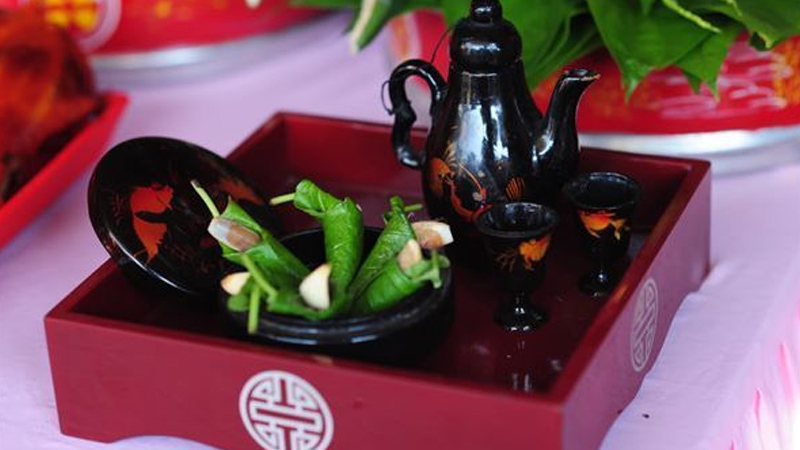 A bottle of wine and a tray of betel nuts are presented by the groom’s family.
A bottle of wine and a tray of betel nuts are presented by the groom’s family.
During this ceremony, representatives of both families gather to discuss and finalize the wedding plans, respecting the regional customs and the wishes of both families.
Note: If the groom’s family is small or has special circumstances, the engagement ceremony can be conducted by a respected elder along with the groom.
Wedding Proposal (Betrothal)
In the past, wedding proposal rituals in central Vietnam were quite intricate and influenced by Vietnamese royal court culture. Today, while central Vietnamese families do not focus heavily on material possessions, they still attach great importance to the ceremony’s rituals.
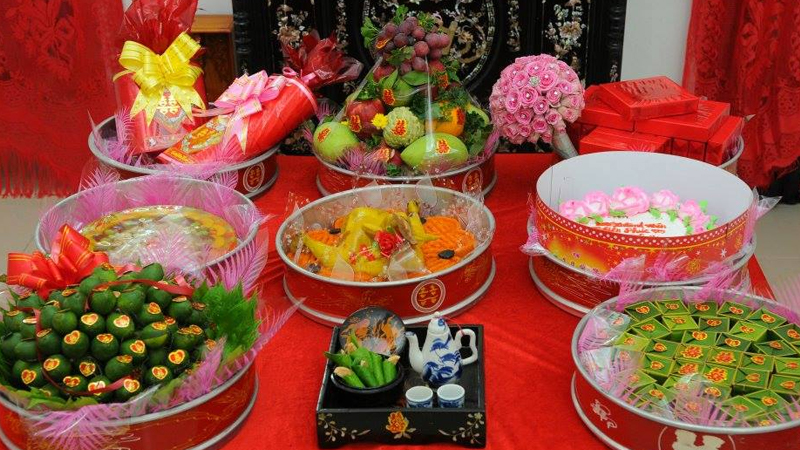 The wedding proposal in central Vietnam values rituals over material possessions.
The wedding proposal in central Vietnam values rituals over material possessions.
When preparing the gifts for the wedding proposal, it is not necessary to choose overly elaborate items. Instead, each step of the ceremony is performed with seriousness and precision.
The essential gifts for the wedding proposal include:
The basic gifts consist of five trays: a tray of betel nuts and areca nuts, a tray of tea and a pair of wine glasses, a tray of engagement cakes, a tray of spring rolls and sausages, and a tray of five types of fruit. Depending on the family, the number of trays and gifts can be adjusted.
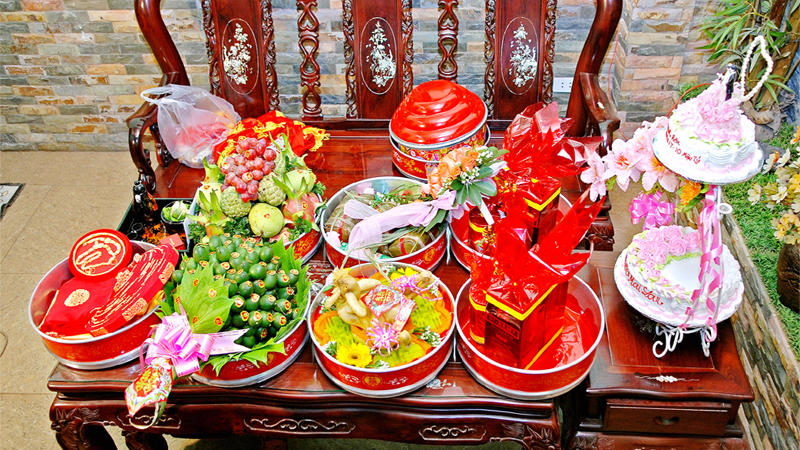 Essential gifts for the wedding proposal.
Essential gifts for the wedding proposal.
For example, if a family prefers not to include engagement cakes, they can substitute a tray of traditional xu xê cakes. However, in this case, the number of trays for the xu xê cakes and spring rolls must be an even number.
In addition to these trays, a small tray containing money, known as the “black gift,” is usually prepared by the groom’s family and placed on the bride’s family altar to inform and honor the ancestors.
For wealthier groom’s families, a tray containing an áo dài (traditional Vietnamese dress) and jewelry, such as a gold necklace and earrings, may be included for the bride to wear during the wedding proposal.
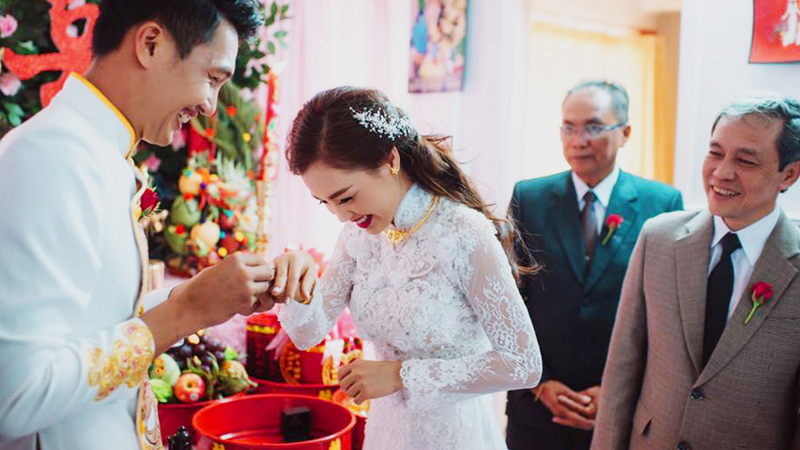 The groom’s family may include an áo dài and jewelry for the bride.
The groom’s family may include an áo dài and jewelry for the bride.
Note: In addition to the “black gift,” the mother-in-law may also give the bride a separate envelope of money as a way of welcoming her new daughter-in-law.
2 Sequence of Wedding Ceremonies
Steps of the Engagement Ceremony
On the predetermined day and time, the groom’s family arrives at the bride’s house with the gifts for the engagement ceremony. The specific steps include:
- The groom’s family arrives at the bride’s house at the agreed-upon date and time to begin the engagement ceremony.
- A representative of the groom’s family greets and introduces the attendees from their side. This representative then expresses the purpose of their visit and presents the trays of gifts, formally asking for the bride’s hand in marriage.
- A representative of the bride’s family thanks the groom’s family, introduces the attendees from their side, and accepts the gifts. After the bride’s parents give their consent, they offer the engagement gifts to their family ancestors and invite the couple to light incense and pray for blessings.
- Both families discuss the wedding proposal, wedding ceremony, dowry, gifts, and timeline, reaching a mutual agreement.
- The ceremony concludes with a friendly meal shared between the two families.
Steps of the Wedding Proposal
Unlike the engagement ceremony, the wedding proposal is a much larger event involving a bigger delegation from the groom’s family and more guests from the bride’s side. The groom’s delegation arrives at an auspicious time previously agreed upon by both families. The delegation includes the gift bearers, or “tráp đội,” who carry the gifts into the bride’s house.
The order in which the groom’s delegation enters the bride’s house is carefully prescribed: First comes the ceremony leader, followed by respected elders of the groom’s family (usually ranked by age or status). Finally, the groom and other young male relatives enter, carrying the trays of gifts.
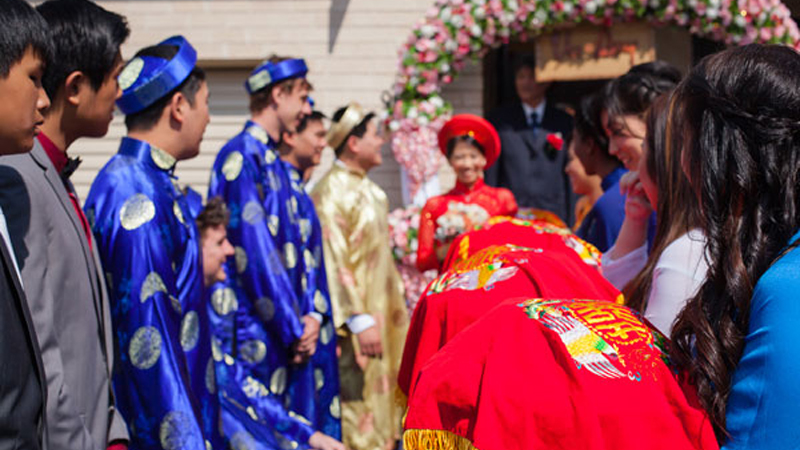 The gift bearers, or “tráp đội,” carry the gifts into the bride’s house.
The gift bearers, or “tráp đội,” carry the gifts into the bride’s house.
After the groom’s delegation enters, the bride is escorted out by either the groom or her parents to participate in the remaining steps of the wedding proposal, including the exchange of gifts, speeches by representatives of both families, and the presentation of gifts to the bride’s family ancestors.
 The bride pours tea for the guests to celebrate the occasion.
The bride pours tea for the guests to celebrate the occasion.
Following the rituals, the bride serves tea and sweets to the guests to celebrate the occasion. Before the groom’s delegation departs, the bride’s family returns a portion of the gifts, known as the “lại quả.” Additionally, the empty trays are left uncovered to signify the bride’s family’s happiness in giving away their daughter and their acceptance of the groom’s gifts.
Steps of the Wedding Ceremony
As the most important part of the wedding process, the wedding ceremony involves a bride-welcoming procession led by the groom’s family, who travel to the bride’s house to escort her to her new home. The bride’s family also sends a few relatives to accompany the bride to her husband’s house.
Related: What is included in the bride-welcoming procession? A detailed guide.
3 Important Considerations for Wedding Participants
According to central Vietnamese customs, the number of people involved in the bride-welcoming procession corresponds to lucky numbers, such as those associated with birth or longevity, to bring good fortune to the newlyweds. Typically, the bride’s escort party is larger than the groom’s welcoming party.
The wedding officiant, or master of ceremonies, plays a crucial role in the wedding process and is carefully selected. Traditionally, this person is an elder from the groom’s or bride’s extended family with a close relationship to the couple and their families. The officiant should be healthy, have a complete family, enjoy a harmonious family life, and have an age that is astrologically compatible with the bride and groom.
The bridesmaids and groomsmen participating in the central Vietnamese wedding process are all unmarried individuals known for their wit and agility.
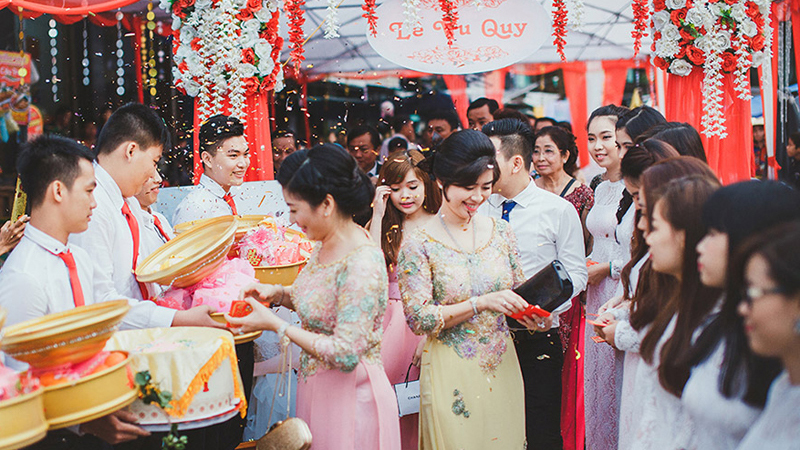 Bridesmaids and groomsmen are all unmarried individuals known for their wit and agility.
Bridesmaids and groomsmen are all unmarried individuals known for their wit and agility.
When the groom’s delegation arrives at the bride’s house, a representative is sent ahead to present the gifts and request permission to perform the wedding rituals. The time for this has been previously agreed upon by both families to ensure a smooth process. If the bride’s family has already set up an ancestral altar, the groom’s family will place a pair of pink candles, which they have brought with them, on the altar.
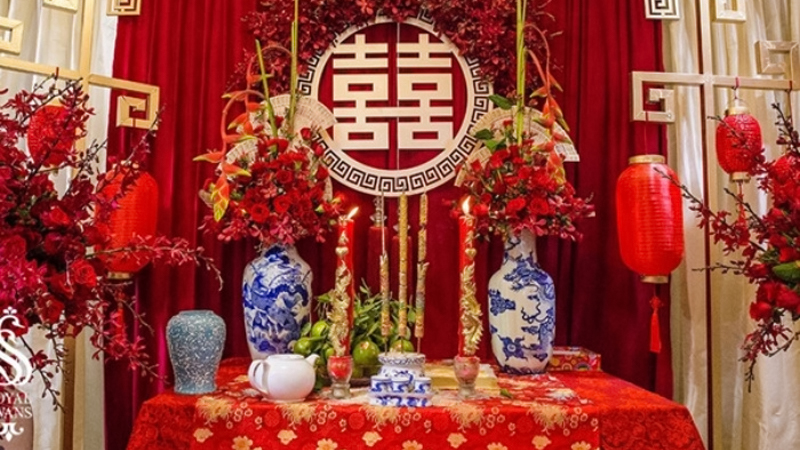 The ancestral altar with pink candles during the wedding ceremony.
The ancestral altar with pink candles during the wedding ceremony.
Once the auspicious time arrives, the groom’s delegation performs the bride-welcoming rituals. After receiving the bride’s family’s consent, the groom takes the bride’s hand and leads her to the car, ready to depart for the groom’s house to continue the wedding rituals. The bride’s family also joins them for the journey.
At the groom’s house, the rituals to welcome the bride are relatively simple. Under the guidance of the officiant, the couple performs the necessary rituals, receives blessings from the groom’s parents, and accepts well-wishes from the guests.
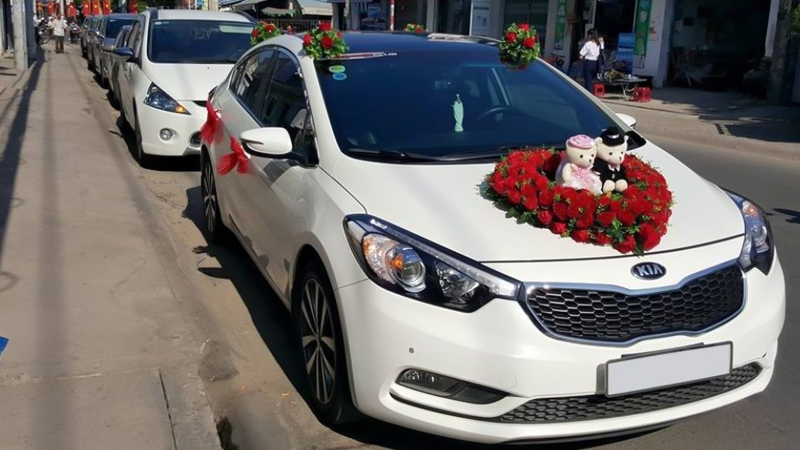 The car that takes the bride to the groom’s house for the wedding rituals.
The car that takes the bride to the groom’s house for the wedding rituals.
Typically, after the ceremony, the bride’s family begins their return journey first. As a farewell gesture, the bride and groom hold a tray of betel nuts and cigarettes, offering them to the bride’s family members. In return, the bride’s family members place some money (usually ranging from 1,000 to 50,000 VND) on the tray as a token of good luck.
Three days after the wedding, the couple pays a visit to the bride’s family. In some cases, the couple may be allowed to visit the bride’s family immediately after the wedding.
4 Superstitions and Taboos in Central Vietnamese Wedding Customs
The following taboos apply to both the groom’s and bride’s families:
Pregnant women are not allowed to decorate the bridal chamber or sit on the wedding bed.
During the wedding procession, the bride should walk straight ahead without turning back to look at her family. This is believed to ensure that the bride will be devoted to her new family and home.
If the procession passes through intersections, rivers, or bridges, the groom’s delegation should scatter some loose change, rice, and salt to ensure a smooth journey.
According to ancient customs, the bride’s mother should not accompany her daughter to the groom’s house. However, in some modern contexts, this taboo has been relaxed, and the bride’s mother may join the procession in a separate vehicle.
Individuals involved in the bride-welcoming and escorting processions should be carefully chosen. Those in mourning are not allowed to participate to avoid bringing bad luck to the couple.
 Careful selection of individuals for the bride-welcoming and escorting processions is important.
Careful selection of individuals for the bride-welcoming and escorting processions is important.
These are the essential customs and traditions of central Vietnamese weddings. We hope this information proves useful to you in the future. Best wishes.
The Ultimate Guide to Arranging Betrothal Gifts According to Customs
Betrothal is a significant ceremony in the traditional Vietnamese wedding customs. Discover the proper way to arrange betrothal gifts and honor the time-honored traditions.

























